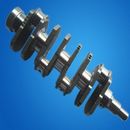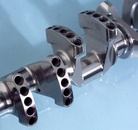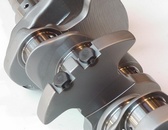Tungsten alloy crankshaft



What is crankshaft?
The crankshaft, sometimes casually abbreviated to crank, is the part of an engine which translates reciprocating linear piston motion into rotation.
How does crankshaft work?
The rods and bearings connects the piston to the crankshaft, when the piston moves up and down, the crankshaft is moved as describing a circle by the rods and bearings, then, the crankshaft is rotating.
Advantages for tungsten alloy crankshaft
Nowadays, modern engine is often made from special metal alloys, and much lighter than earlier engines. So the powder and performance of a modern engine are increased. Also, material for crankshaft has been improved, and tungsten alloy is more and more used as the material for crankshaft.
It is necessary to provide counterweights for the reciprocating mass of each piston and connecting rod to improve balance in engines, and these are typically cast as part of the crankshaft. Lead is cheap but the density is much lower than tungsten heavy alloy, and it is not environmental friendly, as for steel, tungsten heavy alloy are more than twice the density of it, so compared with other materials, tungsten heavy alloy is certainly considered t as the most appropriate crankshaft material for its properties as follows:
- Small volume but high density
- Excellent hardness
- Superior wearing resistance
- Good corrosion resistance
- Wonderful Shock resistance
- High melting point
- High temperature resistance
- Environmental friendly
Related Links
Tungsten Rod
Tungsten Sheet
Material Safety Data Sheet of Tungsten Alloy
Material Safety Data Sheet of Tungsten Alloy (PDF)
Catalog of Tungsten Alloy Products (PDF)















